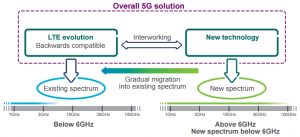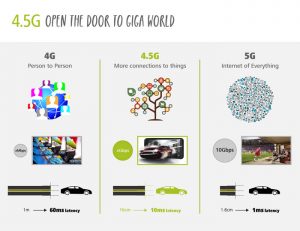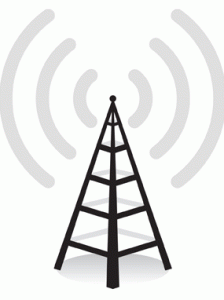What is 5G?

5G radio access technology will be a key component of the Networked Society. It will address high traffic growth and increasing demand for high-bandwidth connectivity. It will also support massive numbers of connected devices and meet the real-time, high-reliability communication needs of mission-critical applications. 5G will provide wireless connectivity for a wide range of new applications and use cases, including wearables, smart homes, traffic safety/control, critical infrastructure, industry processes and very-high-speed media delivery. As a result, it will also accelerate the development of the Internet of Things. ITU Members including key industry players, industry forums, national and regional standards development organizations, regulators, network operators, equipment manufacturers as well as academia and research institutions together with Member States, gathered as the working group responsible for IMT systems, and completed a cycle of studies on the key performance requirements of 5G technologies for IMT-2020.
The Aim of 5G
The overall aim of 5G is to provide ubiquitous connectivity for any kind of device and any kind of application that may benefit from being connected. 5G networks will not be based on one specific radio-access technology. Rather, 5G is a portfolio of access and connectivity solutions addressing the demands and requirements of mobile communication beyond 2020.

The specification of 5G will include the development of a new flexible air interface, NX, which will be directed to extreme mobile broadband deployments. NX will also target high-bandwidth and high-traffic-usage scenarios, as well as new scenarios that involve mission-critical and realtime communications with extreme requirements in terms of latency and reliability.
In parallel, the development of Narrow-Band IoT (NB-IoT) in 3GPP is expected to support massive machine connectivity in wide area applications. NB-IoT will most likely be deployed in bands below 2GHz and will provide high capacity and deep coverage for enormous numbers of connected devices.
Ensuring interoperability with past generations of mobile communications has been a key principle of the ICT industry since the development of GSM and later wireless technologies within the 3GPP family of standards.
4G to 5G Evolution
In a similar manner, LTE will evolve in a way that recognizes its role in providing excellent coverage for mobile users, and 5G networks will incorporate LTE access (based on Orthogonal Frequency Division Multiplexing (OFDM)) along with new air interfaces in a transparent manner toward both the service layer and users. Around 2020, much of the available wireless coverage will continue to be provided by LTE, and it is important that operators with deployed 4G networks have the opportunity to transition some – or all – of their spectrum to newer wireless access technologies.
For operators with limited spectrum resources, the possibility of introducing 5G capabilities in an interoperable way – thereby allowing legacy devices to continue to be served on a compatible carrier – is highly beneficial and, in some cases, even vital. At the same time, the evolution of LTE to a point where it is a full member of the 5G family of air interfaces is essential, especially since initial deployment of new air interfaces may not operate in the same bands. The 5G network will enable dual-connectivity between LTE operating within bands below 6GHz and the NX air interface in bands within the range 6GHz to100GHz. NX should also allow for user-plane aggregation, i.e. joint delivery of data via LTE and NX component carriers. This paper explains the key requirements and capabilities of 5G, along with its technology components and spectrum needs.
In order to enable connectivity for a very wide range of applications with new characteristics and requirements, the capabilities of 5G wireless access must extend far beyond those of previous generations of mobile communication. These capabilities will include massive system capacity, very high data rates everywhere, very low latency, ultra-high reliability and availability, very low device cost and energy consumption, and energy-efficient networks.
MASSIVE SYSTEM CAPACITY
Traffic demands for mobile-communication systems are predicted to increase dramatically. To support this traffic in an affordable way, 5G networks must deliver data with much lower cost per bit compared with the networks of today. Furthermore, the increase in data consumption will result in an increased energy footprint from networks. 5G must therefore consume significantly lower energy per delivered bit than current cellular networks. The exponential increase in connected devices, such as the deployment of billions of wirelessly connected sensors, actuators and similar devices for massive machine connectivity, will place demands on the network to support new paradigms in device and connectivity management that do not compromise security. Each device will generate or consume very small amounts of data, to the extent that they will individually, or even jointly, have limited impact on the overall traffic volume. However, the sheer number of connected devices seriously challenges the ability of the network to provision signaling and manage connections.
VERY HIGH DATA RATES EVERYWHERE

Every generation of mobile communication has been associated with higher data rates compared with the previous generation. In the past, much of the focus has been on the peak data rate that can be supported by a wireless-access technology under ideal conditions. However, a more important capability is the data rate that can actually be provided under real-life conditions in different scenarios.
- 5G should support data rates exceeding 10Gbps in specific scenarios such as indoor and dense outdoor environments.
- Data rates of several 100Mbps should generally be achievable in urban and suburban environments.
- Data rates of at least 10Mbps should be accessible almost everywhere, including sparsely populated rural areas in both developed and developing countries.
VERY LOW LATENCY
Very low latency will be driven by the need to support new applications. Some envisioned 5G use cases, such as traffic safety and control of critical infrastructure and industry processes, may require much lower latency compared with what is possible with the mobile-communication systems of today. To support such latency-critical applications, 5G should allow for an application end-to-end latency of 1ms or less, although application-level framing requirements and codec limitations for media may lead to higher latencies in practice. Many services will distribute computational capacity and storage close to the air interface. This will create new capabilities for real-time communication and will allow ultra-high service reliability in a variety of scenarios, ranging from entertainment to industrial process control.
ULTRA-HIGH RELIABILITY AND AVAILABILITY

In addition to very low latency, 5G should also enable connectivity with ultra-high reliability and ultra-high availability. For critical services, such as control of critical infrastructure and traffic safety, connectivity with certain characteristics, such as a specific maximum latency, should not merely be ‘typically available.’ Rather, loss of connectivity and deviation from quality of service requirements must be extremely rare. For example, some industrial applications might need to guarantee successful packet delivery within 1 ms with a probability higher than 99.9999 percent.
VERY LOW DEVICE COST AND ENERGY CONSUMPTION
Low-cost, low-energy mobile devices have been a key market requirement since the early days of mobile communication. However, to enable the vision of billions of wirelessly connected sensors, actuators and similar devices, a further step has to be taken in terms of device cost and energy consumption. It should be possible for 5G devices to be available at very low cost and with a battery life of several years without recharging.
ENERGY-EFFICIENT NETWORKS
While device energy consumption has always been prioritized, energy efficiency on the network side has recently emerged as an additional KPI, for three main reasons:
- Energy efficiency is an important component in reducing operational cost, as well as a driver for better dimensioned nodes, leading to lower total cost of ownership.
- Energy efficiency enables off-grid network deployments that rely on medium-sized solar panels as power supplies, thereby enabling wireless connectivity to reach even the most remote areas.
- Energy efficiency is essential to realizing operators’ ambition of providing wireless access in a sustainable and more resource-efficient way.
The importance of these factors will increase further in the 5G era, and energy efficiency will therefore be an important requirement in the design of 5G wireless access.
For More Information
Please Contact Us for more information on 5G and IMT-2020
You must be logged in to post a comment.